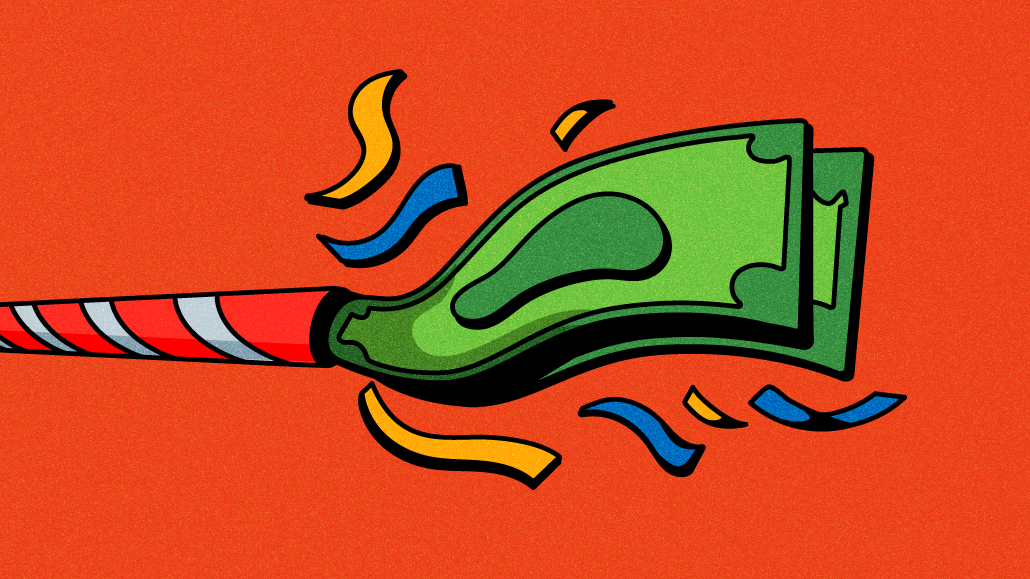Join us Dec. 1-3 in New Orleans for the Digiday Programmatic Marketing Summit
Marketing Briefing: United Airlines, Costco, Chase. Everything is an ad network. Now what?

This Future of Marketing Briefing covers the latest in marketing for Digiday+ members and is distributed over email every Friday at 10 a.m. ET. More from the series →
The introduction of new ad networks continues apace.
Late last week, United Airlines became the first airline to unveil a media network with its rollout of Kinective Media. It’s not the only new media network, of course. News of Costco’s new yet unnamed ad network, which is now reportedly in beta tests, trickled out last week. And a few weeks prior, JP Morgan Chase added its own offering to the mix, Chase Media Solutions, making it clear that marketers need to add Financial Media Networks (FMNs) to the growing list of ad networks to watch.
If you feel like everything is turning into an ad network that might be because, well, everything is turning into an ad network. It’s not all that surprising. Companies with heaps of consumer data are seeing the incremental revenue that other companies (so far mostly retailers and pharmacies) are gaining by creating ad networks and are wanting to get a piece of that ad revenue for themselves. Pitching advertisers on their own data offerings amid the increased push for privacy and third-party cookie crumble (despite Google’s latest delay) makes sense to media buyers and marketers.
“The top 100, 150 brands, if they’re sitting on a lot of data at scale, they’re suddenly realizing that [by] creating an ad network, whether you want to say a retail media network or an ad network totally, that they’re sitting on a lot of potential revenue,” said Jennifer Kohl, chief media officer at VML. From the companies that are rolling out these new ad networks, there’s a sentiment of, “I’m sitting on a lot of data at scale and I know there’s marketers out there that are interested in it so let me try to sell it,” explained Kohl.
More ad networks are certainly coming this year. The question — aside from naming conventions as ad networks expand far beyond the retail media mainstays — isn’t so much one of how many ad networks there will be but how many will survive and thrive. There are only so many ad dollars to go around and very few marketers have the ad budget to spare to test all of the various new ad networks.
There doesn’t seem to be much concern about the influx of new competitors in this space, according to sources who spoke to Digiday for this article. United, for example, believes its point of differentiation in being able to “play at both the brand and the performance” space will help it stand out amid other ad networks, explained Richard Nunn, CEO of MileagePlus.
“I come from a programmatic space, from sort of a [ad] network 1.0 [world],” said Nunn. “I think what’s happening [now is a network 2.0 with a lot of these media networks being stood up. The reality is, if you’re subscale, if you don’t have the quality of data and can’t deliver both the brand and performance message, [it will be difficult to compete].”
Nunn added: “Ultimately, from a brand perspective, trying to interact with 180 different retailers is super hard. And you’re not going to do that. Scale becomes important.”
The pitch of scale is common when you ask both the new and old players in the ad network space about the onslaught of ad networks. Marketers love numbers. Reaching as many eyeballs as possible is a big issue. So if you’ve got the scale that’s certainly one way to appeal for more ad dollars.
Scale is just one element that marketers use to determine which of the ad networks is right for them. Quality of the data is another element that networks tout when pitching advertisers on their offering.
Chase, for example, believes its offering will appeal to advertisers because of its proximity to purchase data and ability to use that data to improve targeting for advertisers. “We can take it to the next level because as long as the data doesn’t leave us, which is very important, then we can actually start to let them target better,” said Chase Media Solutions’ president Rich Muhlstock, who noted that Chase is not selling its ad data, but collecting intel from what a merchant wants, reaching their customers then utilizing Chase data to deliver that to them. “There’s much greater personalization for what you do.”
Kroger, meanwhile, believes its longevity in the market as well as its continued work to beef up its capabilities will help it stand out despite the increase in ad networks. “There’s a huge amount of infrastructure that needs to go into being a credible ad network,” said Brian Spencer, marketing director, Kroger Precision Marketing at 84.51. “It’s much more than just, ‘Hey, we have some first-party data.’”
Aside from scale and quality of data, first-party data stability, individual mindset and consumer behaviors, measurement and attribution as well as how serious an ad network seems to be all factor in as well, explained Steven Frey, director of integrated media planning at Media by Mother.
“Getting discerning about which one of these guys is serious about making a real push here versus someone who read in the Harvard Business Review that you could get an extra 5% on your margin if you stand up a quick tech stack on this is challenging to do from the outside,” said Frey, noting the difficulty for marketers and the help that media buyers can offer with the ad network glut. “But you do tend to get a sense of [who is serious when you see] progress made or when there is a continued conversation about certain players in the market.”
It’s the whole cream rises to the top argument. Even if ad networks are pitching themselves as one-stop shops, which many are, noted Kohl, not all of the ad networks will be successful. Eventually we’ll likely see some partnerships or consolidation of some kind. But we’re not there yet. Right now, we’re still watching new players enter the market with 2024 as the year everything became an ad network.
3 Questions with Brett Heyman, founder and creative director of Edie Parker, a fashion brand
Edie Parker sits at an interesting intersection as a brand that sells fashion accessories and cannabis-related products. How do you market those things simultaneously?
In some ways, it’s really hard, especially when we launched. People are like, “Wait, you make $1,000 custom bags in America and then cannabis?” Honestly, we thought when we launched, perhaps very naively, we have this [long-standing] customer, and our [long-standing] customer, Edie Parker was varied. We thought, because cannabis is becoming so de-stigmatized, that there’s going to be a lot of people who are [long-standing] customers that are going to love Flower [Edie Parker’s smoking accessories and cannabis collection] and it turns out we could not have been more wrong.
What makes you say that you were wrong?
Really, the Venn diagram of people who were [long-standing] customers and Flower customers is like this. It did not really overlap. So in some ways, it’s cool because we can speak to a lot of people in different areas. But it does create a lot more work, just because of the onerous marketing restrictions around cannabis.
Cannabis regulations have loosened some. How does that impact your marketing efforts?
We just work within the confines of whatever is legal. We work with an agency. Some stuff [gets] taken down, we get stuff not approved, you can’t boost our posts that are not approved. It’s a lot of trial and error. We’ve obviously gotten smarter. People have gotten smarter generally about what’s acceptable or not. We have worked so hard to be compliant [with] new packaging and new regulations. It’s frustrating when we can’t share that in a national, global way.
It’s really just finding the areas where you can be successful and compliant. And again, as I said, we have a lot of other product categories. That’s what we focus on. — Kimeko McCoy
By the numbers
News publishers have worried for some time that marketers’ squeamishness about their ads being shown next to war, crime and economics reporting threatened their ability to cover those subjects properly. Marketers countered that “bad news stories” don’t help shampoo sales. A survey of 50,000 American consumers from agency network Stagwell suggests those fears are overblown. The HarrisX study found ads placed next to coverage of inflation and crime were associated with almost the same level of purchase intent as sports coverage. See key data points from its survey below:
- 70% was the average purchase intent among mothers for brands with ads placed against coverage of inflation and business, only 2% more than stories about subway gun crime — suggesting neither “bad news” economics stories nor lurid crime reporting are bad for brands.
- 65% was the average purchase intent among young Gen Z consumers for brands with ads running next to “high-quality” coverage of the Middle East.
- 72%: the average favorability rating from “affluent” household respondents, for brands with ads placed against coverage of the presidential election — only 2% less than coverage of non-political stories. — Sam Bradley
Quote of the week
“It’s very difficult to plan [for] what the world is going to look like in 12, 18, 24 months’ time in terms of gen AI tools.”
— Tom Betts, Kingfisher’s chief data officer, when asked about the company’s AI chatbot.
What we’ve covered
- What it will take for advertisers to finally get ready to let go of the third-party cookie
- The definitive Digiday guide to what’s in and out at Cannes 2024
- How AI’s energy needs conflict with media agencies’ carbon reduction efforts
More in Marketing

How Kind snack bars is using AI to curb creative, marketing costs at business ‘inflection point’
Adopting generative AI and synthetic audiences, Kind North America’s marketing overhaul is cutting creative time and shifting agencies into strategic partners.

As would-be buyers and critics circle, WPP’s siege mentality deepens
The London holding company is beset by challenges and critics. A bunker philosophy and pushback may be emerging in response.

‘We’re in a league of our own’: How X is planning to take over the World Cup, starting with Draw Day
The platform is using the tournament’s draw as an early proving ground for a broader strategy to reassert its creator content around live events.








